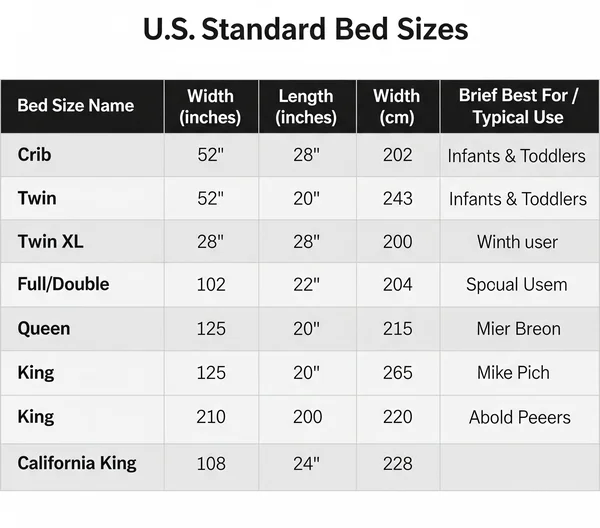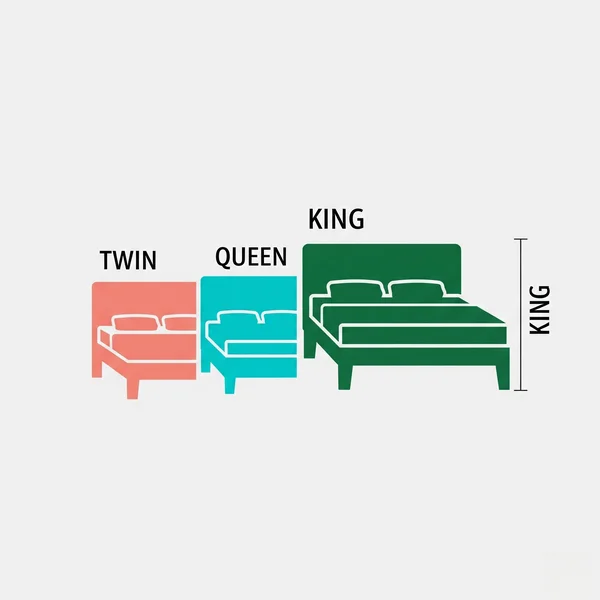Bed Sizes Chart: Dimensions in Inches & CM
Your Go-To Bed Size Chart: All Standard Dimensions & Uses
Choosing the right bed size is fundamental to creating a comfortable and functional bedroom. With so many options available, from a cozy Twin to an expansive King, understanding the exact bed dimensions can feel overwhelming. What are the standard bed sizes anyway? This ultimate guide is designed to be your go-to resource, featuring a comprehensive bed sizes chart with all US standard dimensions in both inches and centimeters, along with a quick overview of their typical uses. Whether you're furnishing a new home, upgrading your mattress, or just curious about your options, this chart will provide clarity. For a complete understanding of each option, explore detailed bed size guides on our site.
The Ultimate Bed Sizes Chart
Below is a comprehensive chart detailing standard US bed and mattress sizes. We've included dimensions in both inches (") and centimeters (cm) for your convenience, alongside a brief note on who each size is generally best for. This mattress sizes chart is your quick reference for all bed sizes.

Understanding Each Bed Size: A Quick Guide
While the bed size chart above gives you the core numbers, here’s a little more context for each:
Crib Bed Dimensions & Use
- Dimensions: Approx. 27.25"-28" W x 51.625"-52" L (70cm W x 131-132cm L)
- Specifically designed for infants and toddlers, fitting snugly into standard crib frames for safety.
Twin Bed Dimensions & Use
- Dimensions: 38" W x 75" L (96.5cm W x 190.5cm L)
- A
twin sizebed is a versatile single sleeper, perfect for children's rooms, bunk beds, daybeds, and smaller guest rooms. It's a common choice for a child's first regular bed.
Twin XL Bed Dimensions & Use
- Dimensions: 38" W x 80" L (96.5cm W x 203cm L)
- The "XL" stands for extra long. It offers the same width as a Twin but with an additional 5 inches in length, making it ideal for taller teenagers, single adults, and the standard for most college dorm rooms. Two Twin XLs also form a Split King.
Full (Double) Bed Dimensions & Use
- Dimensions: 54" W x 75" L (137cm W x 190.5cm L)
- Often called a "Double," a
full sizebed provides more width than a Twin, suiting single adults who like more room. It can accommodate a couple, but it will be quite cozy (27 inches per person). A good option for guest rooms or smaller master bedrooms.
Queen Bed Dimensions & Use
- Dimensions: 60" W x 80" L (152.5cm W x 203cm L)
- The most popular mattress size in the US, a
queen sizebed offers a comfortable amount of space for most couples (30 inches per person) and is also a luxurious choice for single adults. It fits well in most master bedrooms.

King Bed Dimensions & Use
- Dimensions: 76" W x 80" L (193cm W x 203cm L)
- A
king sizebed provides maximum personal sleeping space for couples (38 inches per person – same as a Twin each!). It's ideal for spacious master bedrooms and for couples who value ample room to spread out.
California King Bed Dimensions & Use
- Dimensions: 72" W x 84" L (183cm W x 213.5cm L)
- A
California kingis 4 inches narrower but 4 inches longer than a standard King. This makes it a great choice for taller individuals or couples who need extra legroom and have a narrower master bedroom.
Tips for Choosing the Right Bed Size Using the Chart
Having this bed sizes chart in inches and cm is a great start. Now, how do you use it effectively?
Consider Your Room Size and Layout
Measure your bedroom. Ensure there's enough space not just for the bed, but also for walking around it (ideally 2-3 feet on each side you need to access) and for other furniture. A larger bed in a small room can feel cramped. The room size is a critical factor.
Factor in the Number of Sleepers and Their Height/Size
- Single Sleepers: Twin, Twin XL, or Full are common.
- Couples: Queen, King, or California King are preferred.
- Sleeper Height: For individuals over 6 feet tall, Twin XL, Queen, King, or California King offer better length.
Align with Your Budget for Mattress and Bedding
Generally, larger bed sizes mean a higher budget for the mattress, frame, and bedding sizes. Factor this into your decision.
Think About Future Needs
Are you buying for a growing child? Do you plan to have pets share the bed? Considering future needs can save you an upgrade later. For more in-depth advice, check out the bed selection guides available on our site.
Beyond the Standards: A Note on Oversized & Custom Beds
While our chart covers all standard bed sizes in the US, you might hear about even larger, non-standard or "oversized" beds.
Mention of Alaskan, Texas, Wyoming King Beds
These include sizes like the Alaskan King, Texas King, and Wyoming King, which are significantly larger than a standard King. They are less common, more expensive, and require custom bedding.
Where to Find Information on Non-Standard Sizes
Finding reliable bed dimensions for these oversized options often requires checking with specialty manufacturers. Our focus here is on the readily available standard sizes.
Why Accurate Bed Dimensions Matter
Knowing the precise dimensions from a reliable bed sizes chart is crucial for several reasons:
For Mattress and Bed Frame Compatibility
Your mattress and bed frame must match in size for proper fit and support. An incorrect match can lead to instability or damage.
For Buying Correctly Sized Bedding (Sheets, Comforters)
Fitted sheets, in particular, must correspond to your mattress dimensions to fit snugly. Flat sheets and comforters also need to be appropriately sized for adequate coverage.
For Effective Bedroom Space Planning
Accurate bed dimensions are essential for planning your bedroom planning layout, ensuring comfortable traffic flow and space for other furniture.
Your Bed Size Journey Starts with the Right Dimensions
Choosing a new bed is an exciting process, and it all begins with understanding the bed sizes available. This comprehensive bed sizes chart aims to be your trusted first step.
Recap: The Value of a Comprehensive Bed Size Chart
Having all US bed sizes with dimensions in both inches and centimeters, along with typical uses, in one place simplifies comparisons and helps you narrow down your options efficiently.
Next Steps: Dive Deeper into Specific Bed Size Guides
Once you have an idea of which sizes might work for you from this chart, we encourage you to explore our detailed guides for each specific bed size. These offer more in-depth information on pros, cons, room layout ideas, and more. You can find all our resources about mattress and bed sizes on our main page.
Common Questions About Bed Sizes & Charts
Here are some common questions related to bed sizes and charts:
What are the standard US bed sizes in order from smallest to largest?
The standard US bed sizes, from smallest to largest, are generally: Crib, Twin, Twin XL, Full (Double), Queen, King, and California King.
How do I convert bed sizes from inches to cm?
To convert inches to centimeters, multiply the inch measurement by 2.54. Our chart provides both for your convenience.
Is there a universal bed size chart?
Bed sizes can vary by country/region. This chart focuses on standard US bed sizes. European (e.g., UK, EU) and Asian bed sizes often have different names and dimensions.
Where can I find a printable bed size chart?
Many websites, including ours, offer articles like this one that you can print for easy reference. (Consider linking to a PDF if you create one, or rephrase if not directly offering a 'printable' version).
How much space should be around a bed?
Ideally, aim for 24-36 inches (60-90 cm) of clear space around the sides and foot of the bed that you need to access. This allows for comfortable movement and making the bed. For more tips on planning your room, visit our bedroom layout guides.